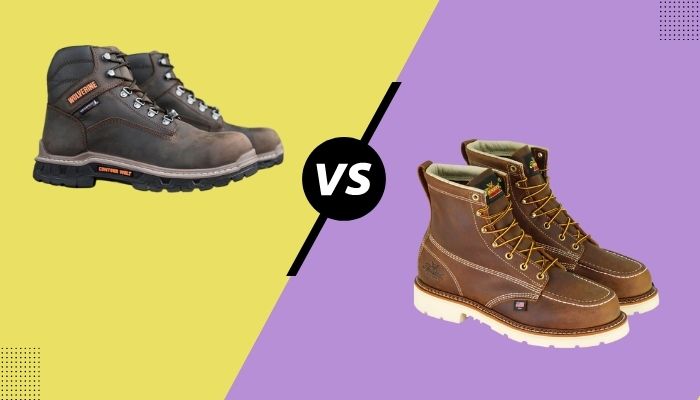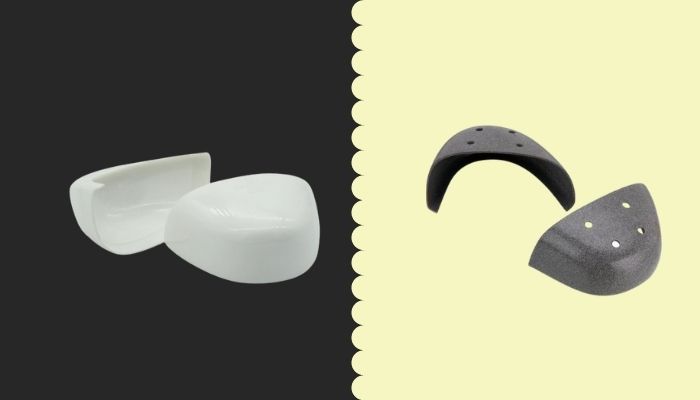Composite toe and steel toe boots are well renowned for their safety features. And, if you want to know who reigns supreme, then you’ve landed in the right place.
After solid research followed up by careful testing, I’ve come up with this much-needed post to help you come to a conclusion.

So, let’s not beat around the bush and get straight into our comparison.
Composite Toe Vs Steel Toe Boots|Key Differences
It’s a given that both our safety boots are different! But, have you wondered exactly on which parameters they differ? If you haven’t, then no worries! I’ve listed them for you. No need to thank me, it’s my duty.
Here are the key differences between the composite toe and steel toe boots:
Upper Material
When it comes to materials, both the toes vary to a good extent. The upper steel toe boots mainly consist of leather, which gives them a great lifespan and the necessary strength to deal with different external forces.
On the other hand, the upper of composite toe boots consists of leather combined with nylon, mesh, or textile. This effective combination gives them their lightweight property and other benefits.
Comfort
When it comes to comfort, composite toe boots are the winners. Steel toe boots are quite stiff in comparison. Although, the stiffness reduces once you complete the break-in period. But yes, if you solely focus on this particular aspect, the composite toe edges this one.
Follow our guide on How Much Do Steel Toe Work Boots Weigh.
Breathability
Leather is a breathable material; upon proper care, they deliver excellent results. Most steel toe boots consist of 100% leather, which makes them quite breathable.
But, composite toe boots consist of a combination of leather and mesh, textile, and other breathable materials, making them more breathable in the process. Mesh or textile is fitted in areas that generate more heat so that you don’t suffer from internal heating for a longer time.
Price
Price is a variable factor, which increases or decreases depending on various factors such as the quality of construction, material, safety standard, etc. But on average, it has been found that composite toe boots cost more than steel toe boots.
Weight
I think you can make an easy assumption on this one! Steel is heavier than composite materials such as kevlar, carbon fiber, or hard plastic. Add 100% leather to that mix, and you end up with heavier boots in general.
Steel toe boots weigh between 3.5-4.5 pounds. It’s quite heavy in contrast to composite toe boots, which weigh between 1.75-4.0 pounds.
Traction
If you consider traction, you’ll see both the steel toe and composite have similar attributes. Both of them are fitted with slip, water, or oil-resistant outsoles. So, it’s a tie when it comes to traction as both the safety footwear offer excellent traction in various conditions.
Protective Cap
Let’s start with the most important one of them all; the protective toe cap! The material used in the construction of these two protective caps gives them unique and distinct properties.
The composite or the non-metallic toe consists of materials such as kevlar, fiberglass, hard plastic, and carbon fiber. All these materials are non-metals as their name suggests and give them distinct properties compared to steel toes.
Speaking of them, the steel toe boots are made up of steel, which is reinforced with thermoplastic polyurethane (TPU) or aluminum. Steel toe has its perks and downsides as well.

You may also like Do Steel Toe Boots Make Your Feet Colder.
Durability
Steel toe boots easily edge over their composite counterparts when it comes to durability. All thanks to the 100% leather and the sturdier build.
Insulation
Steel toe boots offer less insulation compared to composite toe boots; it’s mainly because of the steel which conducts the cold efficiently. Composite toe boots are non-metals, so they do not work cold. Plus, they’re generally more insulated than steel toe boots.
Outsole
Usually, steel toe boots and composite toe boots are equipped with highly durable rubber soles, which provide excellent traction in various working conditions.
Also read, Is Non-Metallic Toe The Same As Steel Toe.
Composite Toe Vs Steel Toe Boots| Are They OSHA Approved?
Yes, both steel toe boots and composite toe boots are OSHA-approved. Both the safety footwear meets the safety standards required by the OSHA (Occupational Safety and Health Administration). Both the boots are meant for different working conditions, and OSHA makes sure you’re well and truly safe.
This really shouldn’t come as a surprise, should it now? Steel toe boots and composite toe boots are meant for different purposes and both of which meet the safety regulations set by the Occupational Safety and Health Administration (OSHA).
For any boots to be approved by the OSHA, they must be slip-resistant, puncture-resistant, able to withstand severe impacts, protect the feet from falling heavy falling objects, and many more.

OSHA instructs workers to put on safety boots for foot protection in certain working environments. And, if the employer fails to ensure its workers with such safe footwear, then the employer must come up against certain fines.
Check out our separate post: Will Steel Toe Boots Set Off Metal Detectors.
Composite Toe Vs Steel Toe Boots|Do They Set Off An Alarm?
Steel toe boots will set off an alarm, while composite toe boots will not set off any alarm. Steel toe boots set off metal detectors due to steel, a metal. Composite toes consist of materials such as kevlar, fiberglass, hard plastic, etc; for which they can’t set off alarms.
One of the most common questions when it comes to these safety toe boots is their ability to pass through metal detectors!
And this is one department where the steel toe passes with flying colors. I don’t know if it’s good news to you or not, but I’m entirely okay with it. Metal will get caught when passing through metal detectors.
I’ve seen many people go through this unnecessary hassle, especially in airports. People wearing steel-toe boots get caught in this baseless doubt.
If you must wear your steel-toe boots, then you can tell the man/woman in charge that you’re wearing steel-toe boots. And, you’ll pass through the detector without having to go through unnecessary questioning.
You can also take off your steel-toe boots and go through the detector, and trust me the person in charge will appreciate your effort.
However, you won’t have to go through such hassles if you wear a pair of composite toe boots at the airport or go through any metal detectors.
Follow our other guide to know Are Military Boots Steel Toe.
Composite Toe Vs Steel Toe Boots| Which Is Best For You?
This is another question I get a lot about safety-toe boots. And, the answer is very simple! It depends on where you work. That’s right! Steel toe boots and composite toe boots are meant for different jobs.
You’ll need steel-toe boots if there’s an increased chance of heavy objects falling on your foot or if there’s a chance your feet have to face any high impact.
On the other hand, composite toe boots are widely used by electricians and engineers since they offer better resistance to electric shocks. They’re also used in construction sites with metal detectors.
If you’re wondering which boot to use in your new job, then don’t! It’s your employer’s duty to provide you with your designated safety boots.
Conclusion
Steel-toe boots and composite-toe boots are meant for different purposes. Both have certain perks and drawbacks. It’s a very rare sight to see both of them on the same platform. To some extent, it’s impossible if you ask me.
If your job requires you to wear safety-toe boots, then it’s your employer’s duty to provide you with adequate knowledge and boots.
Both of them meet the safety standards required by the OSHA. So, you won’t have to worry about their ability to protect you. You just have to ensure, you’re wearing the right boot at the right time.
That’s all from me today. I sincerely hope you’ve had your answer. And, if you didn’t, feel free to let me know down in the comment section below. Until then, takecare.




